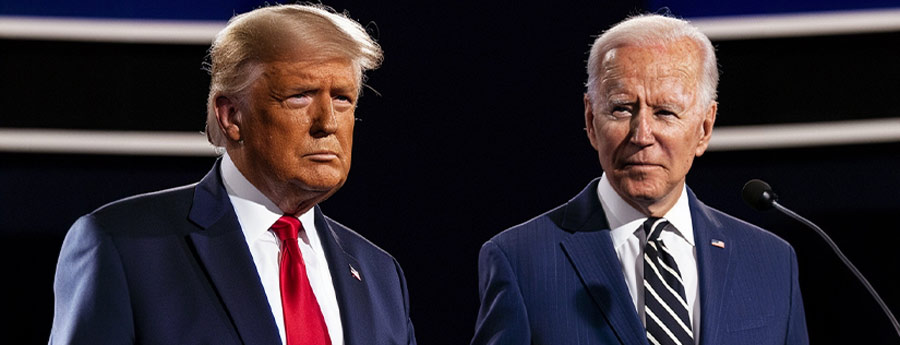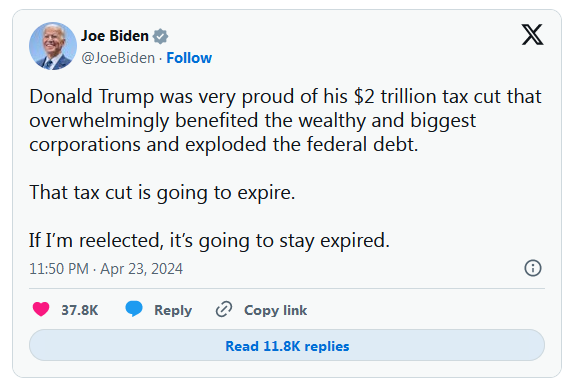
We already know that Bidenomics hasn’t helped American families in their economic struggles.
 Bullion.Directory precious metals analysis 13 June, 2024
Bullion.Directory precious metals analysis 13 June, 2024
By Peter Reagan
Financial Market Strategist at Birch Gold Group
Persistent inflation and higher taxes have already taken their toll on family budgets.
Back in April 2023, the Department of Ways and Means Committee Chairman Jason Smith chimed in on the financial devastation that just one Biden term has imposed:
The Biden Administration’s $10 trillion spending spree sparked and fueled this crisis. Instead of focusing on helping workers, the Biden Administration pushes for 87,000 IRS agents to audit middle-class families and tax credits for the wealthy to buy electric vehicles. Those are not solutions that will bring American families – who have seen $10,000 stolen from their wallets – relief.
In terms of tax hikes, the United States Senate Committee on Finance added their comment in March 2023:
“The President’s budget calls for nearly $5 trillion in new and increased taxes,” said Senate Finance Committee Ranking Member Crapo. “If realized, these plans would create a tax regime that would lead to some individuals handing over more than half of their paychecks to the government, and many American businesses doing better off being headquartered overseas.”
Now that the Tax Cuts and Jobs Act of 2017 (TCJA) is set to expire, there’s another wave of tax hikes on the horizon. We’re likely to foot the bill in an unprecedented way.
Here’s a quick summary of the new situation:
The Tax Cuts and Jobs Act of 2017, or TCJA, temporarily reduced taxes for most Americans. Many of those tax breaks will expire after 2025 without changes from Congress. Former President Donald Trump wants to extend all TCJA provisions, while President Joe Biden aims to extend tax breaks for taxpayers under the $400,000 threshold, which is most Americans. However, there are lingering questions about how to pay for TCJA extensions amid the federal budget deficit.
The expiration of temporary tax reductions results in higher taxes.
Nobody wants to pay higher taxes! So both presidential candidates have proposals to fund those tax reductions.
Let’s take a look at the competing plans…
President Joe Biden’s death tax
If we take Biden at his word, then every provision of the TCJA would be history just because he wants it to “stay expired.”

One Kiplinger column revealed Biden’s death tax that would partly replace the TCJA on re-election:
Let’s illustrate the current rules and Biden’s proposal with a simple example: When Amy’s dad dies, she inherits assets that her dad bought years ago for $300,000 that is now worth $7 million.
Under current law, the $6.7 million appreciation isn’t subject to income tax, and Amy takes a $7 million tax basis… Six years later, Amy sells the assets for $7.5 million. Amy pays tax in the year of sale on her $500,000 gain.
Under Biden’s proposal, the assets would be deemed sold upon the dad’s death… the dad’s final federal income tax return would reflect a gain of $1.7 million ($6.7 million minus the $5 million exclusion) and would show tax due from the deemed sale.
See, normally we don’t pay taxes on assets until we sell them. (This proposal really adds a new dimension to the old saw “you can’t take it with you,” doesn’t it?)
Taxing the deceased isn’t enough, though:
Biden also calls for nearly doubling the capital gains tax for upper-income [earners] by taxing gains as ordinary income to the extent taxable income exceeds $1 million.
According to the Tax Foundation, Biden’s tax plan would increase a number of different taxes, depending on income source. Here’s a summary:
- Increase the corporate income tax rate to 28%
- Double the global intangible low-taxed income tax rate to 21%
- Repeal the reduced tax rate on foreign-derived intangible income
- Expand the net investment income tax to non-passive business income
- ax long-term capital gains and qualified dividends at ordinary income tax rates for taxable income above $1 million
- Tax unrealized capital gains at death (above a $5 million exemption, $10 million for joint filers)
- Tax carried interest as ordinary income
About 4 million (out of 131 million) American households earn more than $400,000. That’s a little more than 3% of the population.
They’re CEOs, hedge fund millionaires and senior business executives, granted.
But don’t forget we’re also talking about working professionals. Doctors and dentists, surgeons and commercial airline pilots, professional athletes and accountants. Successful entrepreneurs and small business owners.
This is just to say I think it’s a mistake to arbitrarily draw a line like this and punish success beyond a certain level. In my mind there’s a big difference between someone who inherits a seven-figure trust fund and someone else who puts themselves through medical school and becomes a successful cardiologist.
Even if their income is the same.
The Trump plan takes a different approach – even so, you will ultimately foot the bill…
The Trump plan: Tariffs
The Tax Foundation also listed some of the ways that taxes would change under a second Trump administration:
- Impose a universal baseline tariff on all imports
- And a 60% tariff on imports from China
- Maintain the 21% corporate income tax rate
For the average person, tariffs are an easier pill to swallow than direct taxes. The money doesn’t come out of our pockets, right? Who cares if China Mobile has to pay higher taxes on the products they import into the U.S.? It’s just the new cost of doing business.
Here’s the thing: Raising producer costs also raises prices. As I wrote way back in 2019:
So who foots the bill for the trade war, various tariffs, and deficits caused by these activities? Answer: According to an official joint study by the Fed and University of Chicago, the consumer pays for it, and dearly.
The motive for increasing tariffs on imports isn’t to raise prices, by the way. The motive is to protect American manufacturing, and to make domestically-produced goods more competitive. The result, however, is higher prices on store shelves near you.
Surprisingly, the Trump position on tariffs isn’t that different from the Biden position:
One of the few tax policy details released by the Trump campaign has been proposed tariffs, or taxes levied on imported goods from other countries, some of which Biden has also supported.
“Directionally, they’re the same on tariffs on China,” Gleckman said, noting that Biden maintained some of Trump’s tariffs and unveiled new ones in May.
The proposed 60% increase on Chinese imports would only raise about $256 billion – which isn’t nothing! But doesn’t even come close to filling in the ocean of red ink on the federal government’s budget.
Speaking of red ink, there’s liable to be more of it:
Now GOP lawmakers and some of Trump’s economic advisers are considering more corporate tax breaks – which could expand the national debt by roughly $1 trillion over the next decade, according to researchers at Stanford University and MIT – arguing that they would improve the U.S.’s global competitiveness.
We’ve already seen the connection between runaway deficit spending and dollar devaluation. We do NOT need to see more of it!
The bottom line is, no matter who gets elected in November, we should expect higher taxes and higher prices.
Finding financial security is becoming more difficult – but not impossible
Listen: The national debt is a $34.7 trillion problem. There aren’t any easy solutions.
Someone has to pay for it. That means:
- Higher taxes
- Greatly reduced government spending
- Increased inflation (“inflating away” the debt)
- …or ALL of the above
The years ahead of us will not be the same as the years behind us. We should plan accordingly.
The good news is, you have the option to diversify your long-term savings with an inflation-resistant store of value asset. One that shelters your purchasing power regardless of what happens in the economy. Right now is a good time to learn about the benefits of owning physical precious metals like gold and silver.
As the election approaches, I expect more and more people just like you will become interested in owning gold and silver. Right now, over in the UK, an upcoming election has citizens queueing up outside the Royal Mint:
The theory is that if the election has any negative economic effect – such as higher taxes or a weakened economy – any money held in gold will sit there smugly unaffected…
The Royal Mint said that it had seen a 49% increase in the number of customers buying precious metal bullion since the election was called.
The election also seems to have nudged many to invest in precious metals for the first time, as 10% of recent Royal Mint customers have never bought gold, silver or platinum before.
My advice to you is not to wait. If you’ve been thinking about diversifying your savings with physical gold and silver, I encourage you to act now. Get ahead of the crowd!
Peter Reagan

Peter Reagan is a financial market strategist at Birch Gold Group, one of America’s leading precious metals dealers, specializing in providing gold IRAs and retirement-focused precious metals portfolios.
Peter’s in-depth analysis and commentary is published across major investment portals, news channels, popular US conservative websites and most frequently on Birch Gold Group’s own website.
This article was originally published here











 Material provided on the Bullion.Directory website is strictly for informational purposes only. The content is developed from sources believed to be providing accurate information. No information on this website is intended as investment, tax or legal advice and must not be relied upon as such. Please consult legal or tax professionals for specific information regarding your individual situation. Precious metals carry risk and investors requiring advice should always consult a properly qualified advisor. Bullion.Directory, it's staff or affiliates do not accept any liability for loss, damages, or loss of profit resulting from readers investment decisions.
Material provided on the Bullion.Directory website is strictly for informational purposes only. The content is developed from sources believed to be providing accurate information. No information on this website is intended as investment, tax or legal advice and must not be relied upon as such. Please consult legal or tax professionals for specific information regarding your individual situation. Precious metals carry risk and investors requiring advice should always consult a properly qualified advisor. Bullion.Directory, it's staff or affiliates do not accept any liability for loss, damages, or loss of profit resulting from readers investment decisions.

Leave a Reply